Text
01/06/2025 – Group Character Design
From Draft to Refinement For the village characters, I began with several rough drafts. However, I eventually removed one design that looked too similar to the grandfather, and refined the remaining ones for better visual diversity. These adjustments weren’t just for variety — I wanted each villager to feel like an individual, with their own presence and hint of story, even if they only appear briefly.
Character Roles and Emotional FramingFor example, the man on the far left is a middle-aged villager who loves to drink — I added a beard to emphasise his age and ruggedness. The little girl sitting on the ground is a character who was bullied in the story and later helped by the protagonist. I kept her anxious posture and expression from the draft, but gave her deep red wavy hair to make her more visually memorable. These subtle details help even minor characters stand out and leave an emotional trace.
Costume Language Reflecting Personality The large, giant-like villager in the centre has a body shaped like a block. I used a stacked beard design to enhance his bulky and honest appearance. The grandmother character is the one who most often uses “tears as emotional pressure” (laugh). Her face and hairstyle are shaped like a giant teardrop. I removed her original exaggerated headpiece and replaced it with a simple bun and symmetrical clothing — echoing her conservative and traditional nature. As for the blonde woman patting the grandmother’s back — I gave her a quiet backstory: she’s the widow of the grandmother’s late son, and often takes care of her in silence. Because she’s shy, her eyes are always hidden behind her fringe.
Overall Strategy for Designing a Group Although most villagers are supporting characters, I wanted to clearly distinguish them from the main cast through visual hierarchy. First, I kept the totem design language consistent, but changed how it's applied — the main characters have totems placed at the core of their bodies, symbolising identity, while the villagers' totems appear more like decorative borders. Second, clothing: the main characters wear more ceremonial or layered outfits, while villagers wear simpler, more practical clothing. Lastly, colour treatment: though everyone shares a similar colour palette, the main cast's colours are more saturated and vivid, while the villagers wear more muted or greyish tones. These choices help maintain visual unity across the cast, while clearly showing character roles and relationships.
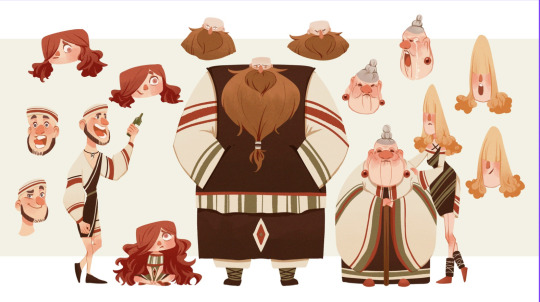
0 notes
Text
28/05/2025 – Character Design Concept: The Making of Iban
The Most Challenging Character – IbanIban was the hardest character to design in this project. I didn’t want him to be just the protagonist’s friend — I wanted him to represent a bridge, both emotionally and culturally. To make his image more grounded, I chose the square as his base shape. This represents his stability, emotional steadiness, and supportive nature. It also hints at the “frames” or limits he places on himself — a sense of duty to his tribe, and a quiet longing for life in the city. He enjoys cooking, so I reflected that in both his props and expressions. For example, he carries a knife that he uses to chop firewood or prepare ingredients — something both practical and personal.
Colour Palette and Character PositioningFor his colours, I continued the common story palette of yellow, black, and red. But for Iban, black is the main tone. This gives him a calm and grounded feeling. Red is used only as a small accent — helping define his supporting role and avoiding visual competition with the protagonist or the grandfather. This choice gives Iban his own space on screen — visually quiet, but never lost.
Childhood Design and Relationship Dynamics I also designed Iban as a child. I made him a little shy and quiet, not just for cuteness, but to show his early relationship with the main character. He and Sayun are childhood friends. Sayun’s lively personality always pushed Iban forward while they were growing up. Now, as adults, their roles have shifted — Iban has become Sayun’s emotional support. Their character arcs reflect and balance each other, creating a relationship that feels real and evolving.Refining Form and Visual Language For the final design, I created a full turnaround, expression sheets, and totem details. His totems follow the same language as the rest of the world, but they are more focused around the centre of his body, especially the lower half. I want these visual elements to act as a silent language — even without dialogue, the audience should feel Iban’s steadiness, warmth, and the quiet hesitation hidden in his heart.

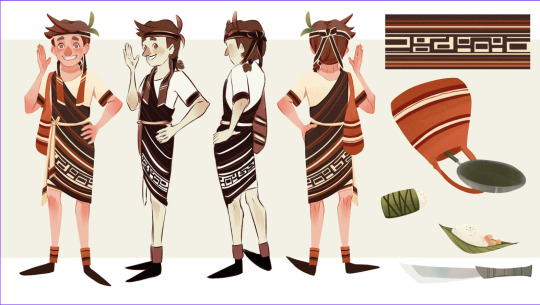


0 notes
Text
26/05/2025 – Character Design Concept: Hayung’s Tradition and Emotional Connection
Character Role and SymbolismHayung is Sayun’s grandfather. In the story, he represents tradition and memory. His design is more traditional and steady. From his head shape to body shape, I used round forms to show his gentle, kind, and wise personality. Like Sayun, he comes from the tribe, but he is more like a guardian and storyteller of the culture. I wanted his design to give a sense of calm, respect, and something sacred.
Symmetry and Visual ThinkingCompared to Sayun’s asymmetrical design, Hayung’s design uses a lot of symmetry. This shows his inner balance and respect for tradition and order. His main shape is the circle — soft and caring, which also fits his role as a strong support for both his family and his community. His outfit is a modified version of traditional tribal clothing. The patterns are neat and slow in rhythm — like a cloth that tells stories.
Colours and Totem Connection For the colours, I kept the classic yellow, red, and black as the main palette. I also added light purple as an accent. Hayung is the only adult character who wears this colour. The only other use of purple is in Sayun’s childhood clothes, which shows the connection between them. Light purple represents spirituality and something sacred. It also hints that Hayung is a spirit weaver, someone with a special role in rituals. In his totem designs, I included Sayun’s symbol — the diamond shape. This shows how culture is passed on, and also strengthens the emotional bond between him and his granddaughter.Totem and Expression Design I created a turn-around, facial expressions, and totem patterns for Hayung. These helped me understand his emotional rhythm and how he should act in the story. Unlike Sayun, Hayung doesn’t struggle with his identity. He is someone who calmly accepts change and looks forward. I hope the audience can feel peace, love, and a sense of cultural continuity through his character.


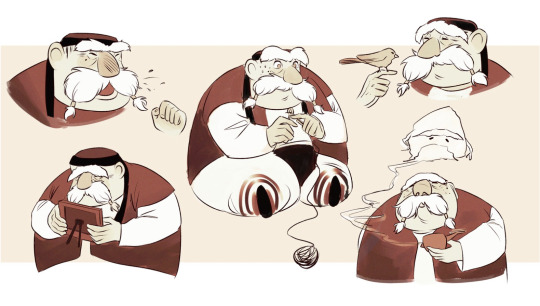
0 notes
Text
23/05/2025 – Character Design Concept: Sayun’s Identity Struggle and Mixed Visual Language
Design Background and General DirectionSayun is the main character of my story. Her design is based on the idea of identity conflict. I want her to show the feeling of someone who grew up in the city but still has a deep connection to her tribal roots. So, I tried to mix both traditional and modern elements in her design. Her clothes are asymmetrical, and the shapes are sharp and edgy. This gives her a more free and unique look, which matches her strong and stubborn personality.
When designing Sayun as a child, I wanted to show her playful nature. This connects with her older self — someone who always chooses a different, less common path. Her childhood outfit also uses asymmetrical wraps and patterns with irregular lines and diamond shapes.
Colour Choices and Cultural MeaningFor the colours, I used yellow, red, and black, which are common in tribal clothing. These colours represent her cultural background. I got inspiration from the traditional colours of the Atayal people in Taiwan, who often use white, yellow, red, and black in their clothes. Red is especially important; it stands for energy, courage, and life. Because of this, both Sayun and her grandfather Hayung wear a lot of red in their designs. I also added light blue to Sayun’s outfit to show the influence of the modern city. At first, I was worried that this would clash with the traditional colours, but later I felt that this contrast actually helped to show her inner struggle and her life between two different worlds.
Outfit and Pattern Design Sayun’s clothing mixes different styles. The lower part keeps the traditional tribal weaving patterns, while the upper part is inspired by modern work clothes. This shows that she is not only a weaver from her village, but also a creator who works in the city. The main patterns I used are diamonds and triangles. These sharp shapes match her personality. However, I’m thinking about whether the patterns are too complex and might affect how easy it is to recognize her character. I plan to adjust and simplify this later.
Extra Design Work and Character Expression To show Sayun’s character more clearly, I also made a turn-around sheet, facial expression designs, and different outfit versions. These designs help show her personality, and make her easier to use in different story scenes. I hope that, just by looking at her, the audience can feel the tension in her story — the conversation between tradition and modern life. She is someone who grows in-between two worlds, carrying the struggle and search for her true identity.
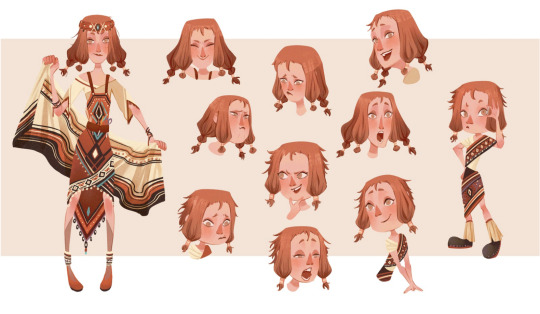
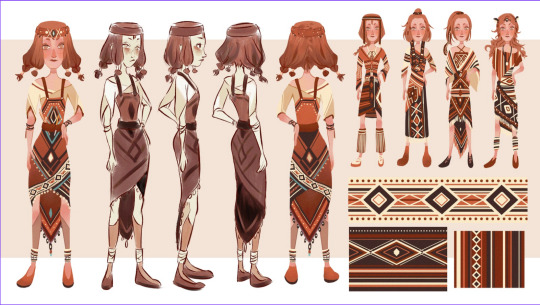
Based on my professor’s suggestion, I made some pose sketches of the main characters to show their personalities and the kinds of actions they might do.
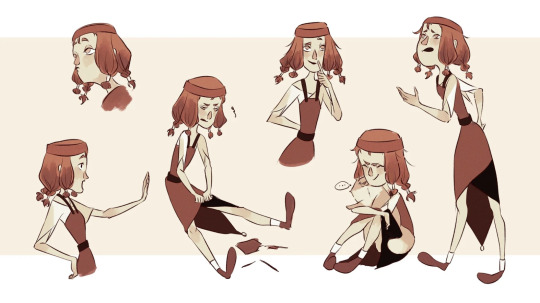

0 notes
Text
25/04/2025 — Schedule, Pitch Deck Prep & Final Thoughts
As I need to prepare for a presentation speech, and I’ve never done a pitch before, I looked up how to pitch an animation project.
Here are some takeaways:
Don’t speak too fast—your audience needs time to process.
Have a logline: one sentence that captures the heart of your story and grabs attention.
Know your target audience.
Mention your inspiration, but make it personal—not just popular references—so people can connect.
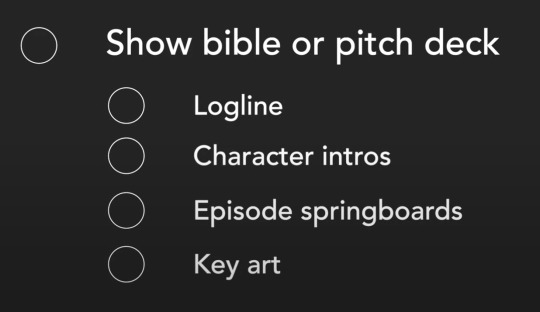
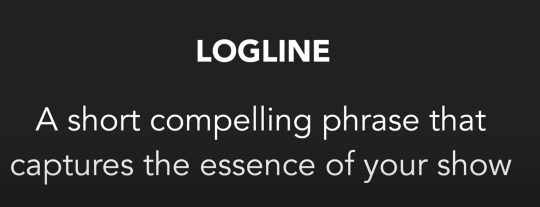
While working on the pre-production document, I included most of my research, character thoughts, and symbolic meanings in detail. But I know I won’t be able to say everything in the pitch—after all, we only have five minutes.
So when making my presentation slides, I focused on the key sketches and re-ordered the visuals. I’ll start with a short story summary, then introduce the characters, and finally explain the worldbuilding and visual inspiration. For important points, I added large text directly on the slides to emphasise them.
I also added small details in the slide visuals. The cover uses bright yellow-green colours to show morning light. Later slides shift to sunset tones, and the final slide uses a night scene to mark the end.



Here are some notes and ideas I gathered while preparing my pitch speech:
Logline: A weaver torn between worlds returns home to summon the dead—only to face the truth she’s been hiding from.
Story Core and Themes As a concept art project for animation, story is the heart of everything. The story explores three universal themes:
Identity
Memory
Facing death
Personal Reflection When my grandmother passed away, the thing I remembered most wasn’t death itself—it was my brother calmly asking, “So what do we do now?” That was the moment I began thinking about how we deal with loss. Although I grew up in an open-minded family, death was still a difficult topic. No one taught me how to handle others leaving—or my own feelings. Throughout my life, I’ve often questioned my identity. I’ve changed myself to fit in, and doubted if I belonged. Even after moving abroad, I kept asking: Who am I? Does what I do matter? Can I call myself an artist?
Story as a Way to Reflect Sayun’s story is my way of exploring these questions—visually and emotionally. Through her, I hope others can see their own struggles, and maybe a bit of hope too.
I’ll only tell the first half of the story in the pitch: It shows emotional change, clear character growth, and ends on a hook to keep the audience curious.
Character Design
A stubborn but kind main character
A grandfather who sacrifices his health for the village
A loyal friend
A cat mascot
Symbolism
Smoke spirit
Pipe
Spirit-weaving ritual
Worldbuilding
The girl’s city workshop
Her grandfather’s home in the village
This is my final reflection on the project. This term has been full of new experiences—from the game project to preparing my final portfolio. As someone without an art background before this course, it’s all been a fresh challenge.
I hope I can finish the final production smoothly. I’ll do my best to manage time well—relax when it’s time to relax, and focus when it’s time to work.
Reference
Write for Animation by Pietro Schito (2023). How to PITCH LIKE A PRO with Scott Wiser. [online] YouTube. Available at: https://www.youtube.com/watch?v=cSmHhTvAVv8 [Accessed 25 Apr. 2025].
Rambling Addict (2024). How to Pitch YOUR Animated Series to TV Studios!! [online] YouTube. Available at: https://www.youtube.com/watch?v=qQ2DP-Gh0v8 [Accessed 25 Apr. 2025].
0 notes
Text
23/04/2025 – Sketch Progress (Cover + Title/Name Ideas)
To give the audience a better idea of the overall style of this story, I started working on the cover sketch for my pitch document.
I first narrowed down the project title to a few ideas: Evanescence, The Last Thread, and Ember. These names reflect the main theme of the story — smoke, memories, and how they fade quickly. I created some cover sketches based on these title ideas.
A. The first sketch is a simple composition using only the side profile of the main character. She is holding an important item from the story — the pipe — and the smoke coming from the pipe forms the project name Evanescence. The dark background helps highlight the light, glowing smoke. This sketch fits the meaning of the word "evanescence" well.
B. The second sketch is a medium shot, showing the upper body of the main character. She is weaving, and her cat Mochi is sitting on her shoulder. One of Mochi’s eyes overlaps with her right eye. Both are looking seriously at the weaving. The pipe is placed on the table, and the smoke rising from it forms the project name The Last Thread.
C. Another sketch based on Evanescence focuses on a glowing pipe. The main character and Mochi are staring at it. The light from the pipe creates strong contrast, and the smoke again forms the project title.
D. For Ember, the sketch shows the main character from the back, with sharp eyes and the pipe in her hand. Smoke from the pipe spells Ember, and glowing embers fall in the background. Mochi is trying to reach for the pipe with one paw.
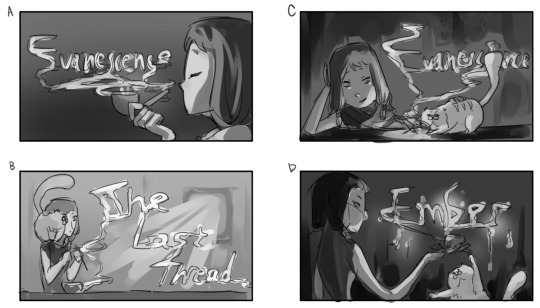
During the class presentation, the professor and classmates seemed to prefer option B and D. The professor said Evanescence might be confusing because it shares the name with a famous band, so it’s better not to use it. He liked The Last Thread because it connects well with my story, especially the themes of smoke and weaving. Some classmates liked Ember because it feels more hopeful and positive.
Later, when I had a tutorial with another professor, he suggested using the main character’s name as the project title. This has become common in animation and film, and audiences are used to seeing non-English names. After looking into common Atayal female names, I narrowed it down to three: Emi, Yumas, and Sayun. I chose Sayun because it sounds the most unique and different from other languages. I decided to use Sayun as the project name, with the subtitle The Last Thread.
After that, I made two more sketches — E and F.
E. One used a top-down angle with strong lighting contrast to highlight the word Sayun (still made out of smoke).
F. In the next version, Sayun is formed from photos (or woven cloths) stacked on the wall. Light and shadow guide the viewer’s eyes to the middle-left area. The main character is in the shadows, holding the pipe. Smoke comes out and wraps around the project name. There are weaving tools on the table, and Mochi is nearby playing with the smoke.

I first chose option F, but while refining the sketch, I realised that having too many characters made the image feel crowded. So I created another version from a low angle, where the focus is on the project name. That version became the one I used to move forward.
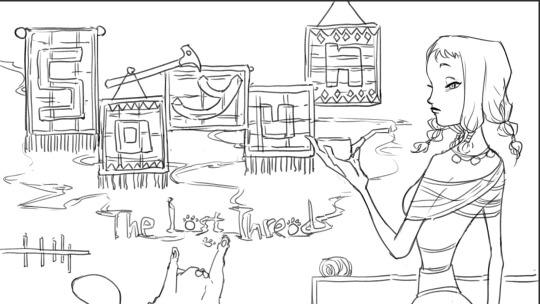
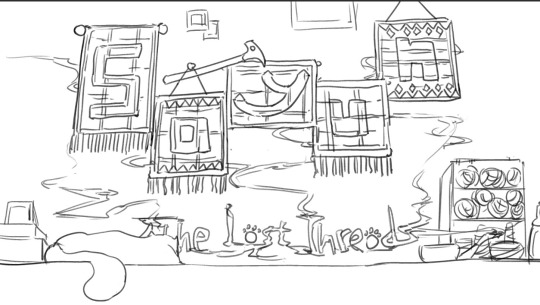
Then I started with simple colour blocks, added a gradient map for the colours, and finished a quick version of the cover sketch.

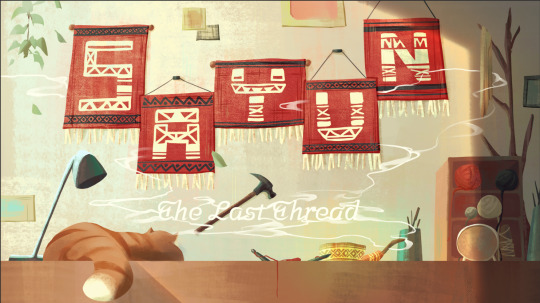
I also gave names to the main characters. The girl is called Sayun, and the cat is Mochi. The main character’s grandfather is called Hayung. In the Atayal language, it’s a male name that also means "tree", which fits because he is like a strong tree who protects the people of the village. The main character’s friend is called Iban, a common male name in Atayal culture.
0 notes
Text
22/04/2025 – Keyframe Progress (Part 2)
Continuing from the last post, I kept working on sketches of important story moments.
The first failed spirit weaving: the summoned spirit is broken and incomplete
A slightly low angle with a tilted frame shows the feeling of imbalance and failure. Moonlight from the window divides the spirit and the protagonist, symbolizing the unresolved emotions between her, her grandfather, and the ritual.
A top-down shot shows her confused and helpless expression. One hand reaches toward the smoke — a gesture full of effort, but ending in failure.
A calm eye-level shot. Though the composition is stable, it clearly shows the emotional distance, the protagonist’s expression, and the use of lighting to separate elements.
Another low-angle shot, but this time from the front. Her exaggerated body language shows her kneeling and trying to catch the broken spirit. The lighting draws a clear divide, and the shot emphasizes the hopelessness of her failure.

A warm memory: childhood with her grandfather She was raised by her grandfather, who loved her deeply. He once summoned his smoke spirit to play with her.
A low-angle shot uses contrast between light and dark to draw attention to the center, highlighting the warm interaction.
Another low-angle, outdoor time this time. The composition creates depth — the protagonist is in the foreground, the smoke spirit in the middle, and the grandfather smiling from afar.
Similar to the first shot but from a high angle. Their body language forms a triangle between the three, showing them as a united group.
A low-angle shot shows them sitting on the steps, talking. The sunset behind them bathes the scene in warm light, symbolizing hope and comfort.

The successful second spirit weaving: reconciliation with herself and her grandfather All three shots show similar actions, but I wanted to explore how different angles affect the visual impact.
This one is eye-level. The stable composition emphasizes warmth, peace, and stability.
A top-down shot doesn’t show the grandfather’s expression, but guides the viewer’s eye to the center of the ritual circle, emphasizing the protagonist’s inner calm and her acceptance of responsibility.
A low-angle shot shows sunlight (hope) pouring through the window, surrounding both the protagonist and her grandfather’s spirit. There is no longer a gap between them. Mochi and the smoke spirit help add depth.


Ending: the protagonist stays in the village, gives her friend the studio key, and teaches weaving to the villagers
This shot focuses on the emotional connection between her and her friend. Light from the bottom left highlights the hand on her friend’s shoulder, showing their support for each other. The light also reveals her other hand passing the key.
A top-down shot shows her teaching a young girl to weave, brushing the hair from the girl’s face. Bright sunlight fills most of the scene (with some shadow to keep form), creating a hopeful and lively mood.
A crowded but warm eye-level shot. Sunlight shines on everyone’s faces. Each person has found their way to face the future and move forward.

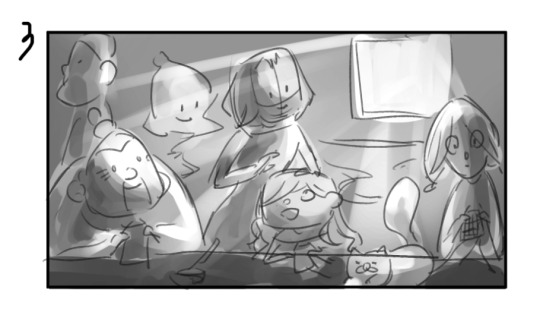
0 notes
Text
21/04/ 2025 – Keyframe Progress (Part 1)
While organizing the story, I also thought about how to present the keyframes. Since these are the imagined scenes from the animation, I often consider the best camera angles and lighting to create strong visual and emotional impact. Below, I’ve divided the explanation by story beats and my thought process during sketching:
The protagonist’s struggle in the city: Although she is Indigenous, the story begins with her living in the city, where she often sells her handmade crafts at a market.
This frame uses a slightly top-down angle, almost at eye-level. The angle is a bit safe, but the lighting divides the protagonist from the city dwellers — she is in the shadows, while the customer is in the light.
This one uses a dramatic low-angle shot. The layout of the stall draws a line between her identity and the buyer’s, showing her internal struggle in the city.
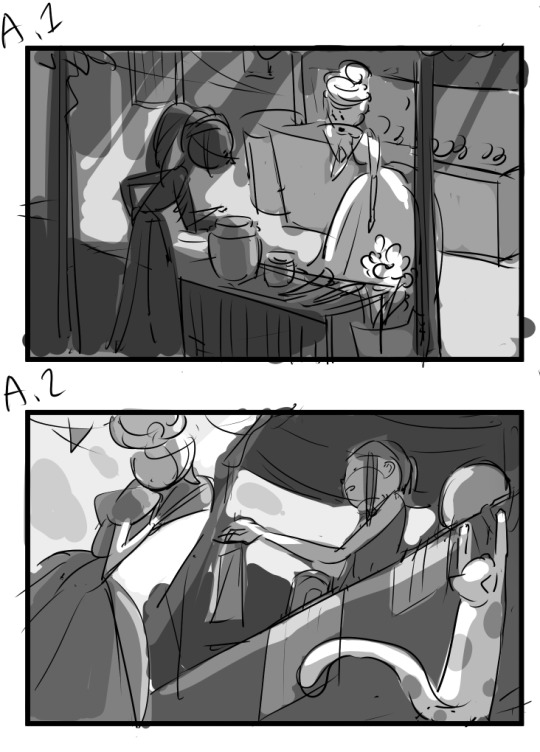
Back at the studio, she learns her grandfather has passed away:
The protagonist is mending a torn cloth, lost in thought. The lighting highlights the figure at the door, who brings the bad news.
A tilted low-angle shot shows her reaction as she stands up in shock. The light falls on her face as she turns toward the door.
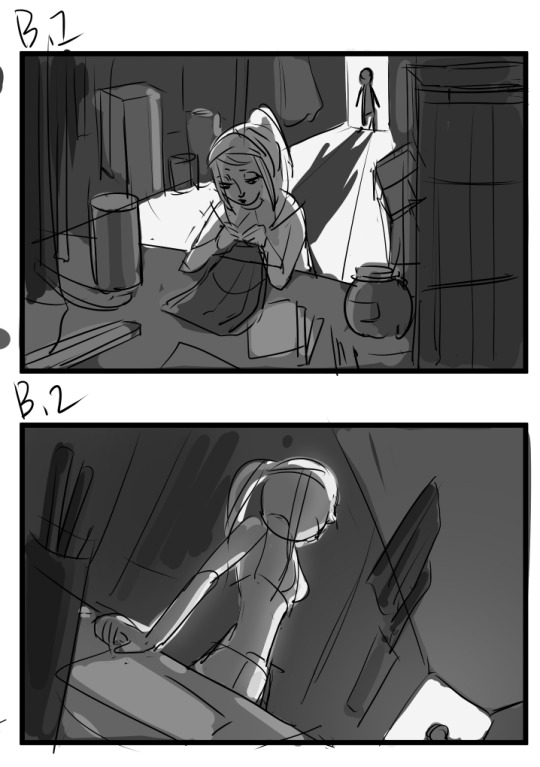
After returning to the village for the funeral, the villagers pressure her to stay and take up her grandfather’s role as a spirit weaver:
She hides behind the wall as villagers gather outside, wanting to speak to her. Though it’s a frontal shot, the close crop lets us clearly see the tension in her expression and how the villagers block the sunlight — showing she has nowhere to run.
She hides behind a cabinet while her friend stands in front to speak on her behalf. But the villagers enter the house anyway, blocking the light (and her hope).
Same scene as before, but now from a high-angle perspective. Mochi the cat observes from above, helping to create depth.
A first-person perspective shows the pressure from the villagers. She grips her cup tightly, her tense expression reflected on its surface. The strong overhead lighting emphasizes the stress in the scene.
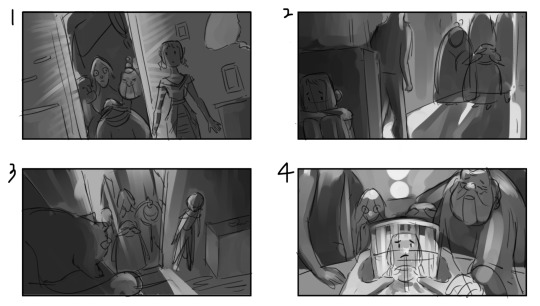
Under pressure and in need of guidance, she tries to summon her grandfather’s spirit with the pipe — but instead summons her own smoke spirit:
A wide shot shows the scale of the ritual. Mochi is placed near the camera to create depth. The protagonist looks up at the smoke spirit; her body language shows her emotion.
Compared to the previous one, this is a mid-shot with a top-down angle. The smoke spirit looks down at the emotionally low protagonist. We can clearly see her surprised expression.
A low-angle shot from behind the protagonist shows the spirit’s size and the emotional weight of the moment. Though we don’t see her face, lighting draws the viewer’s focus to the center of the composition.
This eye-level shot uses lighting to highlight the emotional gap between the protagonist and the spirit. Although the spirit is part of her, they still don’t understand each other yet.
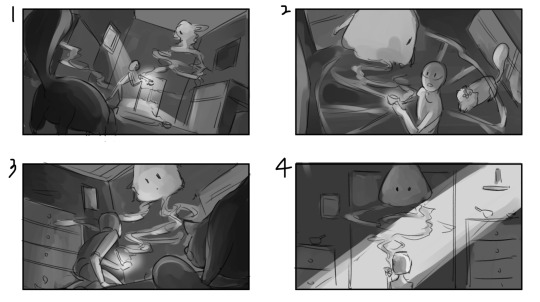
0 notes
Text
20/04/2025 – Sketch Progress (Environment + Prop Design)
I created several sketches of the environment and props to help build a world where cultural memory and personal emotion are closely tied together.
First, I drew the ritual scene. In the story, to summon a smoke spirit from the pipe, the ritualist needs an item filled with memory—like an old photo, toy, or another meaningful object. This is burned together with specific herbs, and the resulting smoke transforms into a smoke spirit. These spirits are key to the weaving ritual and represent echoes of the past.
During the ritual, the ritualist sits in a circle of smoke and weaves the spirit into something cloth-like. This isn’t just a spiritual act—it’s a transformation of emotion and memory into something visual. The final woven cloth becomes physical and holds a pattern representing the spirit of the deceased. I hope this ritual not only fits the story but also expresses the idea of memory being reshaped through creation.
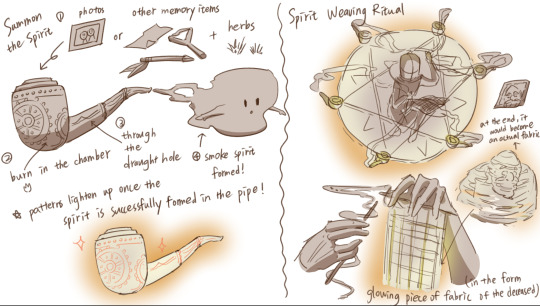
For props, I designed pipes and several versions of smoke spirits. Each pipe is made of three parts—front, middle, and end—and I combined different geometric shapes to give it an asymmetrical but harmonious look. I also added totem-like patterns to reflect cultural symbolism and mystery. These pipes are both tools and personal symbols, showing the user’s background and identity.
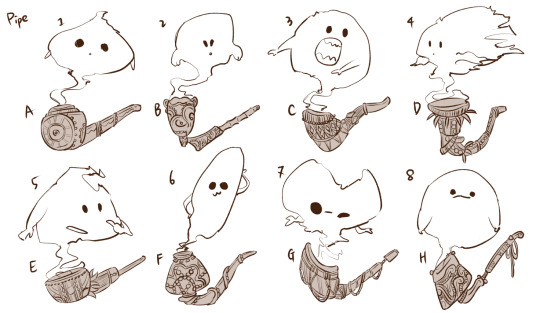
To bring the setting closer to the main character’s cultural roots, I sketched her grandfather’s house—her home before she left, and the main place where the rituals happen. I studied traditional Taiwanese Indigenous architecture and found that bamboo, thatch, and wood are common building materials, giving a strong natural and handmade feel.
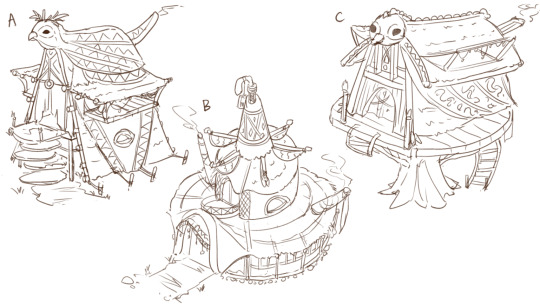
I also added design elements based on the Taiwan Alcippe morrisonia (a type of bird), which relates to the Atayal people’s bird-watching rituals.

This gives the house a more visible cultural symbol. For colours, I used the traditional red, black, and white of the Atayal tribe, along with the yellow of thatch, to make the building more recognizable and culturally rich.
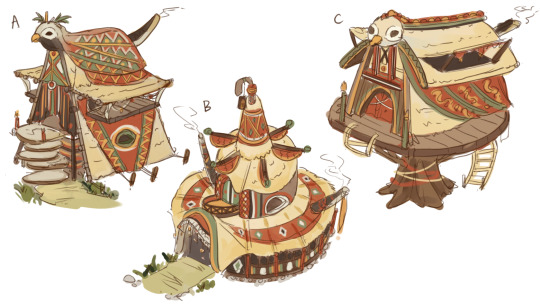
I also designed the interior of the house. I used warm tones to create a soft, memory-like atmosphere. I included a loom, bird totems, and ritual items to make the space both a home and a ritual site.
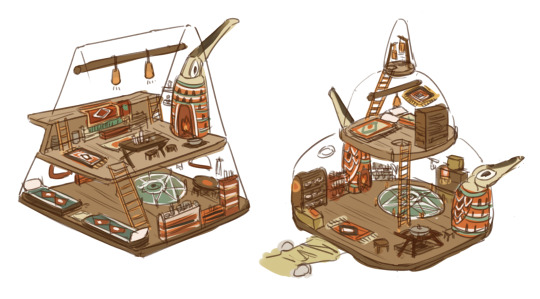
In contrast, I also designed the city studio. I wanted the difference in space and colour to reflect the main character’s inner conflict about her identity. The city studio focuses on textile art. I looked at real weaving workshops and included messy work tables, yarns, and fibre artworks.

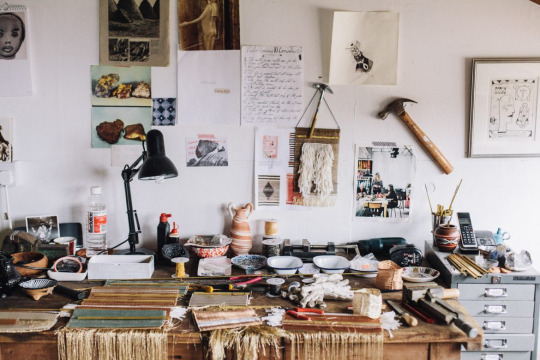
The overall colour palette is cool, but some warm tones remain in her creations and a few pieces of furniture. This colour contrast expresses her emotional struggle of self identity.
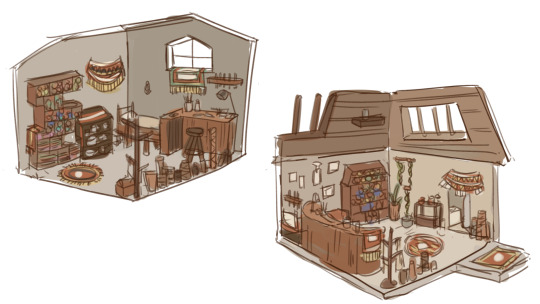
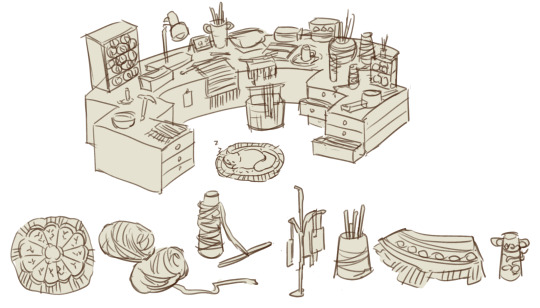
All Environment Design Reference Pictures

Reference
Wikipedia (2012). 維基百科,自由的百科全書. [online] Wikipedia.org. Available at: https://zh.wikipedia.org/zh-tw/.
夢夢 (2017). 師資&工作室 – 夢夢 x 手作. [online] 夢夢 x 手作. Available at: https://emily.com.tw/about/ [Accessed 20 Apr. 2025].
Zeng, Y. (2019). Maker Spirit|織起神祇、眾靈與天幕:走進編織藝術家 Justine Ashbee 工作室. [online] POLYSH. Available at: https://thepolysh.com/blog/2019/10/12/justine-ashbee/ [Accessed 20 Apr. 2025].
Crespo, R.V. (2023). Book Illustration Layout. [online] Pinterest. Available at: https://www.pinterest.com/pin/462181980524570084/ [Accessed 20 Apr. 2025].
Collecting Stufff (2022). Concept Art Building. [online] Pinterest. Available at: https://www.pinterest.com/pin/633387440165315/ [Accessed 20 Apr. 2025].
Munala risoer (2025). 学生作品—单体设计, 雁甲 CG艺术. [online] Pinterest. Available at: https://www.pinterest.com/pin/14988611254467724/ [Accessed 20 Apr. 2025].
ArtStation. (2025). 学生作品, Pei-Gong场景概念&百昼艺术设计. [online] Available at: https://www.artstation.com/artwork/GeBmnQ [Accessed 20 Apr. 2025].
Pinterest. (2019). Your profile. [online] Available at: https://www.pinterest.com/pin/59672763807673070/ [Accessed 20 Apr. 2025].
Pinterest.com. (2025). Blocked Page. [online] Available at: https://www.pinterest.com/pin/69102175527652901/ [Accessed 20 Apr. 2025].
Pinterest. (2019). Your profile. [online] Available at: https://www.pinterest.com/pin/387731849180687839/ [Accessed 20 Apr. 2025].
lilith (2022). Disneysea Tokyo. [online] Pinterest. Available at: https://www.pinterest.com/pin/1196337396994942/ [Accessed 20 Apr. 2025].
Pinterest. (2019). Your profile. [online] Available at: https://www.pinterest.com/pin/633387442426100/ [Accessed 20 Apr. 2025].
エイギ (2023). 《竹》, 麦狗子. [online] Pinterest. Available at: https://www.pinterest.com/pin/703756185720034/ [Accessed 20 Apr. 2025].
Tinh Tế Tròn (2024). Leaf Roof Design. [online] Pinterest. Available at: https://www.pinterest.com/pin/72198400272030638/ [Accessed 20 Apr. 2025].
desing (2023). Disneysea Tokyo. [online] Pinterest. Available at: https://www.pinterest.com/pin/446349013082265312/ [Accessed 20 Apr. 2025].
Ward, T. (2021). Tree House Drawing. [online] Pinterest. Available at: https://www.pinterest.com/pin/183662491052904089/ [Accessed 20 Apr. 2025].
marasigan, marvin (2024). Httyd Berk Village. [online] Pinterest. Available at: https://www.pinterest.com/pin/27373510230845856/ [Accessed 20 Apr. 2025].
Bubba (2023). Viking Room. [online] Pinterest. Available at: https://www.pinterest.com/pin/153403931054102045/ [Accessed 20 Apr. 2025].
Tacp.gov.tw. (2025). Available at: https://www.tacp.gov.tw/CulturalPark/AreaGuideDetail?ID=7f997853 [Accessed 20 Apr. 2025].
Tacp.gov.tw. (2025). Available at: https://www.tacp.gov.tw/CulturalPark/AreaGuideDetail?ID=3ba8c9ab [Accessed 20 Apr. 2025].
新唐人亞太電視台. (2016). 自然資材蓋房子!原民青年找回原始風格 - 新唐人亞太電視台. [online] Available at: https://www.ntdtv.com.tw/b5/20160530/video/172660.html? [Accessed 20 Apr. 2025].
0 notes
Text
19/04/2025 – Sketch Progress (Character Interaction)
As the story gradually took shape, I began imagining how the characters might interact. So, I turned those ideas into a few rough interaction sketches. Since I haven’t fully decided on the faces of the main character and her friend yet, I just used generic figures as placeholders for now.
At the start of the story, I designed a small scene between the main character and her pet cat, Mochi, as a source of inspiration. Mochi is her fluffy, lively companion—the only one with her in the city. While cleaning the studio, she accidentally kicks Mochi, and that little moment becomes a mirror that reflects her current mental state.
Later in the story, after the main character returns to her village and summons a smoke spirit, Mochi becomes very curious about it. He enjoys chasing the smoke and often plays with the spirit. During one of their playful moments, he accidentally knocks over a pipe and a bundle of threads. That’s when the main character has a sudden thought: “Maybe smoke can become part of the ritual.” This idea doesn’t just come from her memories of her grandfather—it’s also something Mochi opens up for her, a new path between city life and cultural roots.
More importantly, Mochi is with her during her lowest emotional moments. His quiet presence is often more comforting than words.
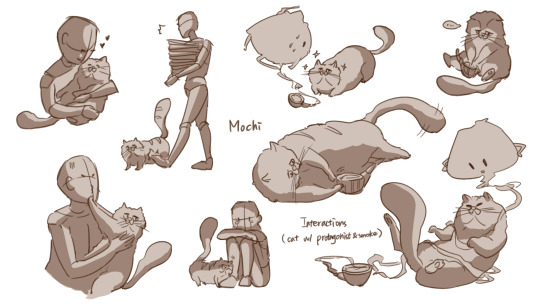
As she reconnects with the village, the emotional weight of her past starts to surface. Iban, her childhood friend, is someone who has always believed in her. One night, they talk about their hopes for the future and memories of the past. Iban dreams of the freedom of the city, while the main character feels overwhelmed by the expectations of the villagers. Though their intentions are kind—they want her to take on her grandfather’s role in the rituals—the pressure is too much.
At one point, she meets a young girl who’s being picked on. Trying to comfort her, the main character wipes her tears with a piece of her own weaving and gives it to her. This moment creates a bond between them. Later, a large villager tries to comfort the girl, but his appearance scares her. Someone else offers alcohol to ease the mood—but the main character doesn’t like drinking. (In some Taiwanese Indigenous cultures, alcohol is used as a symbol of peace and connection to the ancestors.)
These scenes are not about conflict, but rather the emotional and cultural friction the main character is going through. In another moment, Iban steps in and asks everyone to give her space. His support shows her that she doesn’t have to carry everything alone.

In one possible ending, the story closes on a quiet yet decisive moment. The main character chooses to stay in the village and work with the others to build a new way forward. She gives Iban the key to her city studio—a symbol of her new beginning, and his. Before they part, he sees her sleeping from exhaustion and realizes her decision comes not from pressure, but from a deep desire to reconnect with her roots in her own way.
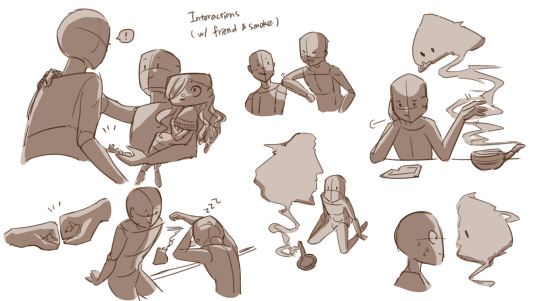
In a ritual practice, she summons a smoke spirit—but it's not her grandfather’s soul. This breaks her expectations and leaves her confused and upset. But this also marks a turning point: she begins to create instead of just trying to recreate.
All of her emotions return to her memories of her grandfather. As a child, she saw him summon spirits with his pipe and thought any pipe could bring him back. She didn’t understand the weight of the ritual—only that he was always taking care of others, often alone. He remembered everyone’s stories, but few knew his own.
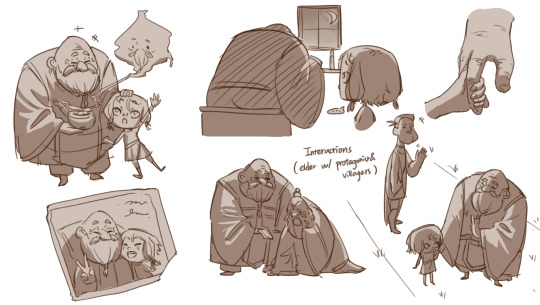
To her, he was both someone to admire and resist. His silence and dedication now reflect back at her. In the end, she understands that what he did wasn’t a sacrifice—it was a choice. And she starts asking herself: can I choose a different way? A way that holds memory but also embraces who I am?
0 notes
Text
18/04/2025 Sketch Progress (Character Part 2 + Color)
Besides the two main characters, I started working on other important characters, like the main character’s grandfather. In the story, he represents wisdom and spiritual strength—not just a family elder, but the guardian of the village. I gave him droopy eyelids, a lot of facial hair, and calm, kind eyes to express warmth and inner wisdom.
I also explored different body shapes and outfit options for him. My classmates seemed to like body types 5 and 6 paired with facial versions A, B, and C, which gave me useful feedback for refining his design.


For his clothing, I used the same approach as the main characters, continuing to reference Atayal colors and patterns. The red, black, white, and yellow base gives the clothing a strong cultural presence. I also used different accessories, totem placements, and fabric textures to show differences in age and status. For the grandfather, I added more symbolic patterns and layers to make him visually stand out as the "spiritual core" of the story.


When designing background characters, I allowed myself more freedom. I didn’t worry too much about their full backstories, and instead focused on variety and contrast. I played with different face and body shapes, poses, and expressions. This process helped me realize that even background characters can carry their own stories.
One of the sketches—a little girl sitting on the ground—caught my professor’s attention. Her posture and expression were very different from the others. This inspired me to give her a deeper role in the story, as someone who influences the main character’s emotional journey.

Initial Sketch
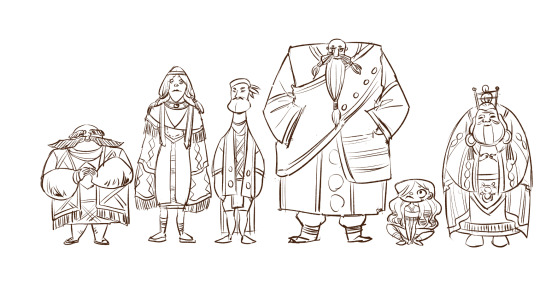
Second Sketch
Finally, I created a rough lineup sketch of all the characters to help myself check the proportions and visual balance between them. Everything is still in the draft stage, so the faces and body shapes will keep evolving. But this stage has already helped me clarify the visual direction I want to go for. It also laid a strong foundation for the next step: coloring and refining the details.
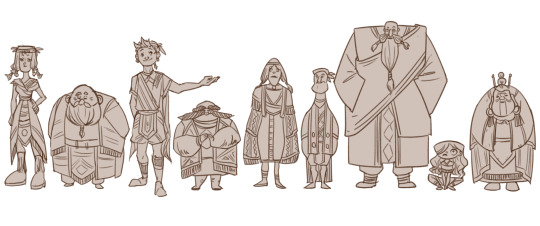
For the colors, I’m still following the Atayal palette—red, black, white, and yellow—with red as the core for its meaning of vitality and protection. I also added green and purple to bring a slight fantasy touch, reminding viewers that this is a fictional world. These colors aren’t just decoration—they reflect the characters’ beliefs and cultural roots.
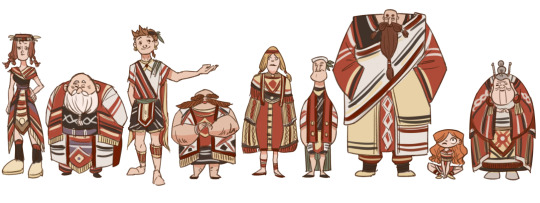
0 notes
Text
18/04/2025 Sketch Progress (Character Part 1 + Color)
For this round of character design, I started with the main character. In the first version of sketches, options C and E were the most popular among my classmates, so I based the second version on these two and created four new sketches. I want her design to reflect her personality—stubborn, perfectionist, but kind-hearted—so I tried different hairstyles and eye expressions, while keeping a consistent emotional tone.

I also designed six different outfits for her. Each one started with simple geometric shapes, then evolved into unique silhouettes and cuts. For the patterns and color palette, I drew a lot of inspiration from the clothing of the Atayal people, one of Taiwan’s Indigenous tribes. Their traditional colors are red, black, white, and yellow. Red is especially important—it symbolizes vitality and bravery, and is believed to ward off evil spirits.

Besides these four main colors, I added touches of green and purple to make the palette richer. Through these costume designs, I want the character to feel not only visually appealing, but emotionally and culturally grounded.

After that, I also started designing the male character—her friend. Compared to the main character, he’s more outgoing and cheerful, so I gave him brighter, more open expressions to match his personality. Like the main character, I also tried various hairstyles and eyes, and designed six outfits for him.
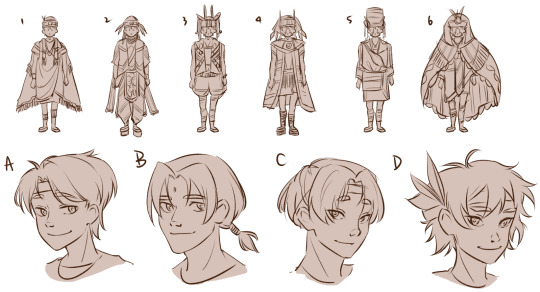
One of my favorite designs is his first outfit. It includes a skirt element often seen in traditional Atayal male clothing, but it doesn’t look too feminine. Instead, it brings a unique cultural elegance to his look.


One helpful comment from my professor made me reconsider the facial features of my characters. He mentioned that they looked too "pretty"—like manga/anime characters. So I started experimenting with more exaggerated face shapes and features, and even drew childhood versions of each character.
For example, Version A of the main character has a triangular face and sharp eyes, to show a more quiet and serious side. Version B has a rectangular face and round, energetic eyes, to express strength and determination. For the male character, Version C has drooping eyes and a calm vibe, while Version D looks younger and has a square face that gives off a reliable and warm feeling.
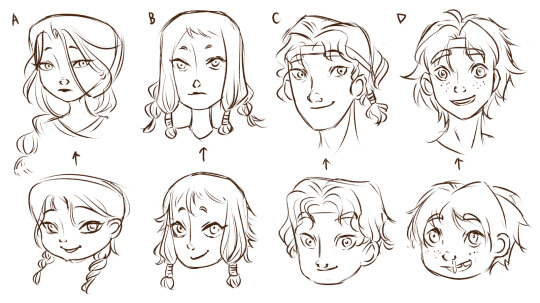
first revision

second revision
I also drew the main character’s cat, who is both her companion and a little mischievous. The cat plays a key role in triggering a story moment—helping the main character realize that smoke is essential to the ritual.

Color Palette

Reference
www.xeuxuecolors.com. (2015). 學學台灣文化色彩 泰雅族 銅鈴長衣. [online] Available at: http://www.xuexuecolors.org.tw/community.php?opt=2&palette=79281 [Accessed 18 Apr. 2025].
www.xeuxuecolors.com. (2015). 學學台灣文化色彩 泰雅族 新娘婚禮用筒袖長衣siparian. [online] Available at: http://www.xuexuecolors.org.tw/community.php?opt=2&palette=7873 [Accessed 18 Apr. 2025].
www.xeuxuecolors.com. (2023). 學學台灣文化色彩 【色彩專欄】質樸有力的原色 | 曾啟雄. [online] Available at: http://www.xuexuecolors.com/column.php?xue=4&id=218 [Accessed 18 Apr. 2025].
0 notes
Text
17/04/2025 — What Jibaro (2022) Taught Me About Visual Storytelling
Jibaro is, in my opinion, one of the most ambitious, visually distinct, and narratively bold episodes in Love, Death + Robots Season 3 — maybe even in the whole series. Directed by Alberto Mielgo, the episode pushed the boundaries of animation on multiple levels. From the siren’s detailed costume full of metallic ornaments to the intense water simulations, every aspect of the production is technically demanding. What impressed me most was that Mielgo refused to simplify any of these elements or hide behind clever editing. For him, the painful production process was part of telling the story — not just showing off.

The characters' movements felt so realistic that I thought it was motion capture or even live-action when I first watched it. But based on interviews, it turns out every movement was created through hand-drawn keyframe animation! Mielgo invited choreographer Sara Silkins and her dancers to rehearse for two weeks, starting not with movement but with emotion, trying to capture the characters’ inner conflicts and desires. Interestingly, dancers also played the soldiers, since their body control was much sharper and smoother than traditional stunt actors — almost like “violent elegance.” That choice gave the whole episode a unique physical tension and made the attraction and confrontation between the characters even more intense.

I think this has important implications for animation in general. Depending on the story’s purpose, it can be powerful to let real people act things out first before animating. It adds a “human touch” to the characters. It reminded me of the behind-the-scenes process of The Little Mermaid, where actors performed scenes for animators to study and recreate. Some gestures or emotions, when only imagined in your head, might feel too abstract or detached from human experience — unless the characters are meant to feel inhuman. That’s something I think I should constantly keep in mind when designing concept art: how to keep things grounded and relatable.


In terms of storytelling, Jibaro barely has any dialogue or narration. It relies entirely on visuals and sound. That perfectly fits my idea of strong visual storytelling — "show, don’t tell." The audience is left to interpret the deadly relationship between the siren and the deaf knight on their own. She’s curious about someone who can’t hear her voice, and he’s obsessed with the gold and jewels on her body. They don’t understand each other, yet they can’t resist each other. Mielgo deliberately avoids giving clear answers. He lets the imagery and dance carry the emotional weight. Because of that, people see different meanings in it and interpret the story however they want— colonialism and greed, desire and revenge, or simply the violent clash between two beings from different worlds.
Some stories don’t need to be “explained”. And for anyone, including me, creating visual narratives, this is a strong reminder to make intentional choices. Every visual decision can carry meaning. The form and content should always serve each other.
P.S. Fingers crossed that Season 4 gives us another mind-blowing masterpiece like this one!
Reference
Denjean, J., Nelson, J.Y., Mielgo, A., Mielgo, A., Miller, T. and Bramble, G. 'Swirv' (2022). Jibaro. [online] IMDb. Available at: https://www.imdb.com/title/tt20239442/.
ScreenRant. (2022). Alberto Mielgo Interview: Netflix’s Love, Death & Robots Vol 3. [online] Available at: https://screenrant.com/love-death-robots-vol-3-alberto-mielgo/.
Youtu.be. (2025). Welcome To Zscaler Directory Authentication. [online] Available at: https://youtu.be/iDl2GFVSTPk [Accessed 17 Apr. 2025].
ShotOnWhat! (2025). The Little Mermaid (1989). [online] Available at: https://onset.shotonwhat.com/gallery/the-little-mermaid-1989/ [Accessed 17 Apr. 2025].
ShotOnWhat! (2025). The Little Mermaid (1989). [online] Available at: https://onset.shotonwhat.com/gallery/a-production-still-the-little-mermaid-1989/ [Accessed 17 Apr. 2025].
1 note
·
View note
Text
16/04/2025 – Spider-Man: Across the Spider-Verse (2023) Thoughts and Technical Breakthroughs
Across the Spider-Verse was my favourite animated film of the year before last. If The Boy and the Heron is Miyazaki’s love letter to 2D animation, filled with emotions and reflections on life, Across the Spider-Verse is a celebration for everyone who loves animation—both creators and viewers. It shows us that there are no limits, whether it’s 2D or 3D.
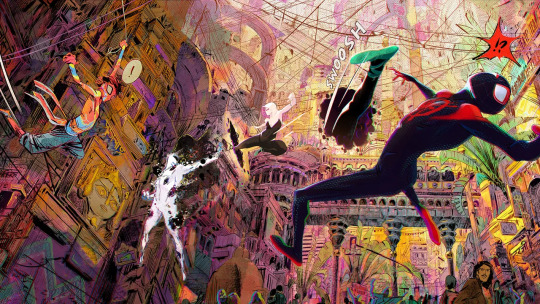
Compared to the previous film, Into the Spider-Verse, this sequel takes things even further. There are more characters, and the visual styles are even more diverse. Each universe has its own unique art style and colour palette, and even though these styles are very different, they manage to blend beautifully on screen. One great example is when a Da Vinci-style Vulture appears in Gwen Stacy’s dreamy, pastel-toned world. Surprisingly, the contrast doesn’t feel messy—it somehow works. In Gwen’s world, the colours also shift depending on her emotions, like a painting that breathes.
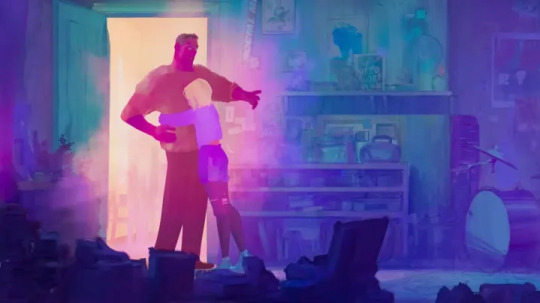
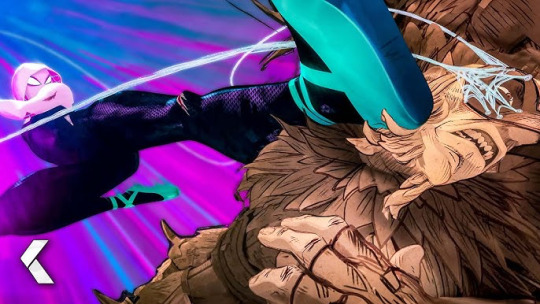
This impressive harmony of clashing styles is thanks to art director Patrick O’Keefe and VFX supervisor Mike Lasker. They managed to make viewers believe that all these “inconsistent” characters could exist in the same frame, which is a huge technical and creative challenge for any animation team. One of the most surprising and exciting characters was Hobie Brown, aka Spider-Punk. He’s a standout not just in style but also in technique—and also one of my favourite side characters in the whole series! I couldn’t stop wondering how the team pulled off his punk, collage-like look and how he moves with a completely different frame rate from the others, yet still fits right in.
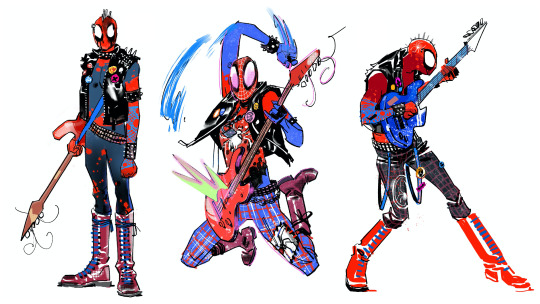
According to interviews, Hobie’s animation uses a very rare approach: different parts of his body are animated at different frame rates. For example, his jacket moves at 4 frames per second, his body at 3, and his guitar at 6. This technique requires separate rigs for each part and creates a chaotic yet rhythmic effect, like a living zine. I think Hobie’s presence is a perfect example of how animation can break the rules and reshape its own language.
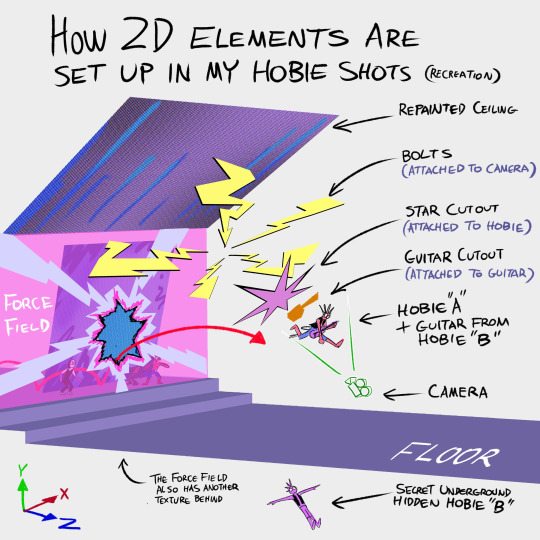
Even though this film is mainly CG, the team included a lot of 2D elements too. Some characters’ faces are hand-drawn over the CG models. One striking moment is when Miguel (Spider-Man 2099) bites Vulture—this shot is directly drawn by animator Humberto Rosa. Other examples include Miles’ sketch-style flashbacks and the surreal black-and-white sequences featuring Spot. These scenes were only developed up to the "playblast" stage, then passed on to studios like Titmouse and Buck for hand-drawn finishing.
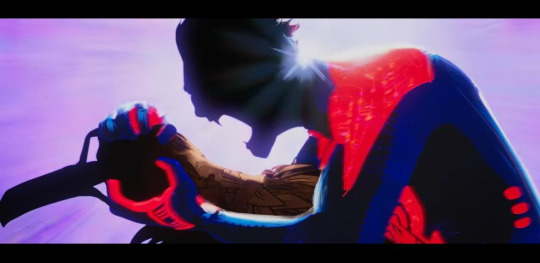
This back-and-forth between CG and 2D blurs the line between traditional and digital animation, and pushes the visual language of the film to a whole new level. It also gives animators and creators confidence that there are still endless ways to experiment and tell stories through animation. These technical and artistic achievements don’t just make the film visually stunning—they also inspire people like me who love animation. The mix of 2D and 3D isn’t a conflict; it’s teamwork. Different styles don’t just represent different universes—they give each character their own storytelling voice. That’s incredibly powerful, and it reminds me why I’m so passionate about this medium.
What makes this film so captivating isn't just the style or the animation breakthroughs—it’s also the way the story is told. The creators manage to weave themes like rebellion, growing pains, and pressure from society into a multi-universe adventure that resonates across cultures and backgrounds. The film reminds us: we don’t have to become who others expect—we can choose to be ourselves. Spider-Man: Across the Spider-Verse isn’t just a chaotic mash-up of characters. It’s a heartfelt, layered story about growing up, making choices, and finding your identity.
Reference
Burt, S. (2023). The Comic-Book Aesthetic Comes of Age in ‘Across the Spider-Verse’. [online] The New Yorker. Available at: https://www.newyorker.com/culture/culture-desk/the-comic-book-aesthetic-comes-of-age-in-across-the-spider-verse.
Failes, I. (2023). The ‘Across the Spider-Verse’ Spider-Punk character Hobie was animated with different frame rates for different parts of his own body and accessories. [online] befores & afters. Available at: https://beforesandafters.com/2023/06/17/the-across-the-spider-verse-spider-punk-character-hobie-was-animated-with-different-frame-rates-for-different-parts-of-his-own-body-and-accessories/.
Digital Trends. (2023). Is Spider-Man: Across the Spider-Verse better than Into the Spider-Verse? [online] Available at: https://www.digitaltrends.com/movies/is-spider-man-across-the-spider-verse-better-than-into-the-spider-verse/.
Clip (2024). Spider-Gwen Fights The Paper Vulture Scene - Spider-Man: Across the Spider-Verse (2023). [online] YouTube. Available at: https://www.youtube.com/watch?v=h6ToKxbKYtc [Accessed 16 Apr. 2025].
Tangcay, J. (2023). ‘Across the Spider-Verse’: How Daniel Kaluuya’s ‘Cool and Controlled’ Vibe Helped Animators Create Spider-Punk (EXCLUSIVE). [online] Variety. Available at: https://variety.com/2023/artisans/awards/spider-punk-hobie-spider-verse-animators-1235707039/.
X (formerly Twitter). (2024). x.com. [online] Available at: https://x.com/LiWenToh/status/1666652467306860544.
Reddit.com. (2023). Reddit - The heart of the internet. [online] Available at: https://www.reddit.com/r/IntoTheSpiderverse/comments/17lukx7/was_miguel_about_to_eat_kill_vulture/ [Accessed 16 Apr. 2025].
0 notes
Text
15/04/2025 Story Reflection: Weaving Spirits and Finding Reconciliation
While developing this story with “spirit weaving” as the central symbol, one question kept coming back to me: Why does the protagonist need to weave? What is she really hoping to gain from it?In the story, spirit weaving is a ritual that can summon memories and connect with the past. But when the protagonist returns to her village, she’s emotionally conflicted. She’s not there for tradition, not for the tribe—it’s because she simply doesn’t know what to do with her life. That’s what drives her to use the pipe and attempt the ritual—not for ceremonial reasons, but personal ones. She’s looking for guidance, maybe even trying to avoid the responsibility of making a choice on her own.
From Rebuilding the Past to Searching for DirectionAt first, her goal is to summon her late grandfather, hoping he’ll tell her what to do. She wants to “recreate the past” through the ritual—bring back a warm conversation, a clear message, something like: “You should stay,” or “You should go.”It’s a longing for certainty, and in a way, a form of escapism. She’s afraid to choose for herself, afraid of the consequences and the unknown. So she turns to memories, to her grandfather.
But in her second attempt at weaving, she doesn’t summon the comforting memory she wanted. Instead, she’s faced with a painful moment—her past self leaving the village in anger.
The Meaning of Memory: Not Guidance, but TrustThat memory doesn’t offer her any answers. What she sees instead is that her grandfather never tried to stop her. In fact, he had quietly slipped a piece of unfinished cloth into her bag before she left. That fabric symbolized something important: his choice to let her go, to let her make mistakes, to fall and find her way—because he trusted that she would eventually weave something of her own.
It’s then she realizes—what she truly needed wasn’t an answer. It was the quiet presence of someone who trusted her, who didn’t judge or interfere. What she gained wasn’t direction—it was the right to choose.
Memory Isn’t Distortion—It’s a Personal Kind of HonestySome might ask, “If a memory is reinterpreted, is it still real?” If the protagonist chooses to see the version of the memory she needs, is that just comforting herself? But I believe this kind of reinterpretation isn’t a distortion—it’s a form of healing and reconciliation. Memories aren’t objective recordings; they’re woven together with our shifting emotions and lived experiences. True spirit weaving isn’t about restoring the past exactly as it was, but about re-understanding our present through those memories—and mending the broken parts of ourselves in the process.
What the protagonist summons isn’t just an image of the past—it’s an emotional memory she finally chooses to face. That scared, angry, fleeing version of herself is finally being seen with kindness.
A New Style of Weaving, A Personal Way of RememberingIn the story, the way the protagonist weaves is completely different from her grandfather’s. His works are consistent and rhythmic, representing a stable narrative shaped by experience. Hers, on the other hand, are more unpredictable—sometimes rough, sometimes emotional, often feeling unfinished. But this contrast isn’t about skill. It’s about creative intent and life stages. Her grandfather weaves for the community, for tradition. It’s protective and rooted. She weaves as a way of exploring, of trying, of finding balance in uncertainty. What she weaves isn’t just cloth—it’s her choices, her emotions. That’s why her weaving carries something new. It’s a different style, but also a new way of understanding.
In the End, She Doesn’t Find an Answer—She Faces the UnknownBy the end, spirit weaving isn’t just a tool to summon memories—it becomes a ritual of inner transformation. She stops trying to “rebuild the past” or “ask for direction,” and starts to believe: Even without a clear future, I can carry the weight of my choices.In this way, spirit weaving evolves from a supernatural ritual into a way of living— Not a method for letting the dead speak, But a way for the living to finally listen to themselves.
0 notes
Text
14/04/2025 Story Notes: Exploring the Concept of Spirit-Weaving
Beyond the story itself, I believe it’s important to explore what the ritual of spirit-weaving truly means in this world. While developing the narrative, I also discovered some issues that needed deeper thought and resolution. Here’s how I’ve been thinking about it:
What is Spirit-Weaving?
In the world of this story, “spirit-weaving” is a ritual art that connects smoke and memory. It’s not just a way to preserve the past, but a process of interpreting and recreating memories. At its core, spirit-weaving has never been about simple restoration—it’s about understanding and making choices.
How Traditional Spirit-Weaving Works
In the village, spirit-weaving rituals are usually performed by experienced elders. When the ritual begins, villagers bring items that belonged to the deceased—such as a pipe, jewelry, photos, or clothing. These items are burned, and their smoke releases spirit-creatures that represent the memories tied to them. The spirit-weaver observes the shapes, movements, and visions within the smoke, then “translates” these clues into woven patterns.
These woven fabrics are not objective recreations of the past, but symbolic memory-films, deeply personal interpretations and farewells created by the spirit-weaver.
It’s important to note: this weaving is not a “true” record of the dead person’s life. It’s a subjective act shaped by the weaver’s emotions and understanding. The traditional spirit-weaver (like the protagonist’s grandfather) might seem to simply “replay” memories, but he quietly mixes in his own spirit-creature—his own perspective and values—into every ritual. His woven patterns may vary from case to case, but his overall style remains the same, shaped by his life experience and sensitivity.
In that way, the weaving process is really a co-creation between the weaver and the spirit-creatures.
The Protagonist’s Starting Point—and Her Failure
At the beginning of the story, the protagonist tries spirit-weaving for the first time, acting more like a follower than a true creator. She carefully follows the steps of the ritual, hoping to recall her late elder’s memories—but she doesn’t include her own feelings or point of view. She sees herself as a “tool,” a faithful executor, not realizing that spirit-weaving requires empathy and interpretation—not just technical execution.
Her first attempt ends in failure: the spirit-creature breaks apart. This reveals a core issue with the ritual—without personal involvement, spirit-weaving loses its soul.
This failure helps the protagonist realize that memories are not just “data” to download. They are something that must be felt, participated in, and recreated. She learns that spirit-weaving isn’t just a way to say goodbye to someone else—it’s a bridge for her to connect with her own memories.
Breakthrough: From Imitator to Creator
Her breakthrough comes when she lets go of her obsession with “rebuilding the past” and begins co-creating with her memories. In the later part of the story, she no longer tries to copy the deceased’s memories. Instead, she adds her own spirit-creature—her own emotions, reflections, and interpretations.
Her spirit-weaving becomes something new: not just a container of someone else’s memories, but a living creation that continues and transforms those memories. At first, she was seeking answers. But in the end, she chooses to walk forward with the memories. This marks a deep internal transformation.
This also sets her apart from traditional weavers like her grandfather. He is the guardian of the village’s memories—quietly holding and interpreting them for others. But the protagonist becomes a translator, a companion, and a creator. She allows others to join the process and lets herself be changed by it.
Different Styles: Grandfather vs. Protagonist
In the world of spirit-weaving, “style” is more than technique—it’s a reflection of the creator’s inner view. The protagonist’s later works show a wide range of styles: some are delicate and poetic, others wild and bold. Some blend the visual language of the city and the village. Each piece gives off a different emotion, depending on the person she’s weaving for.
This variety doesn’t come from fancy skills, but from her willingness to fully “participate” each time. She listens to the person’s story, walks with them through their pain, and lets herself be affected. Every ritual becomes a new conversation—a true co-creation.
In contrast, her grandfather’s weaving is consistent and calm. His pieces always have a certain “style”—a steady rhythm and structure, like a protective frame for memories. Though the people behind the woven patterns are all different, the emotion in the work remains steady. It gives the village a sense of peace and emotional balance.
His consistent style is not a limitation—it’s a choice. He chooses to be a container of memories, hiding his own emotions behind the cloth. His weaving is like a sacred part of the ritual: stable, reliable, and expected.
The protagonist’s weaving, on the other hand, feels like life itself—messy, ever-changing, sometimes uncertain, but deeply human. She no longer just “translates” memories—she invites them into her world, allowing them to meet and transform her. That’s how her uniquely styled weavings are born.
Redefining Spirit-Weaving
Through the protagonist’s journey, we see that the true nature of spirit-weaving shifts—from a “semi-subjective restoration” to a process of shared creation and responsibility. It’s no longer just an echo of the dead—it becomes a choice the living make about how to face memory.
A spirit-weaving ritual isn’t only about saying goodbye—it’s about forming a new connection, a living one.
“The person we wish to see again was never just an image of the past—but the version of ourselves in that memory.”
The true meaning of spirit-weaving isn’t to rebuild what was lost, but to allow the living to understand the past and reweave a new path forward.
0 notes
Text
13/04/2025 Character Arc
🔹Protagonist (Main Character)
Initial personality and state:Introverted, sensitive, creative but lacks direction. Stubborn and perfectionistic. She built some confidence in the city but was still confused about her identity. Deep longing for a sense of belonging.
Motivation / Core need:She wants to find her own path and be affirmed by her elder. She hopes to be understood and to create something that truly connects with others.
Character arc:
Avoidance (refuses to become a spirit weaver) → Craves guidance from her elder (tries to summon grandfather’s smoke spirit using the pipe, fails, then tries spirit weaving) → Experiences failure (realizes copying the past brings no answers) → Interacts with friend, memories are reinterpreted (understands memories are subjective) → Begins to face her own creativity and interpretive power → Performs a second spirit weaving, this time including her own smoke spirit → Understands that “farewell” is not giving up, but a form of responsibility and moving forward → Chooses to stay and becomes a new kind of connector/creator

🔹Friend
Initial personality and state:Lively, outgoing, slightly self-deprecating. Loves the village but feels uncertain about the future. Envious of the protagonist’s city life and curious about the outside world.
Motivation / Core need:Wants to be seen and have the freedom to choose. Doesn't want to simply inherit tradition, but to make their own choice.
Character arc:Encourages protagonist to stay → Tries to imitate protagonist’s work → Accidentally inspires her → Helps her face failure and trauma → Realizes their own talents can also help others (e.g., teaching villagers and kids) → Accepts the key to protagonist’s studio and decides to go to the city to pursue their own dream
🔹Elder
Personality and narrative role: Warm yet firm. A connector within the village. Always hoped the protagonist would find her own path—not just replicate tradition but keep it alive.
Symbolic role:His death is what brings the protagonist home. His spirit weaving records hold wisdom about responsibility and choice. He is the key between protagonist and the village, and between protagonist and the past.
Function in spirit weaving scenes: He doesn’t give “answers,” but encourages the protagonist to choose for herself. Says something like:
“You don’t need to become me. I’ll always be here—whatever you choose.”
🔹Villagers
Initial state:Guardians of tradition and conservatism. Fear the loss of culture and worry no one will continue spirit weaving, so they place hope and pressure on the protagonist.
Spirit weaving ritual:It’s the only way to recreate moments with the deceased, allowing people to see loved ones again or hear unspoken words. Villagers bring relics of the dead as “fuel” to summon these memories or conversations—making the ritual both sacred and practical. After the elder’s death, the only person who knew the ritual is gone, so they anxiously rely on the protagonist.
Turning point:After the friend questions them and the protagonist rejects the pressure, they realize that too much expectation only drives people away. They eventually apologize and try to accept her choice in a new way.
Narrative function:They symbolize collective pressure and cultural anxiety during transition. Their later shift represents a more open and flexible community.
🔹Cat (Non-human character; symbol of intuition and spontaneous insight)
Personality and function:Free-spirited, playful, often acts unexpectedly. Seems to interrupt but actually pushes things forward. A companion to the protagonist, often appears during her anxious moments and breaks her train of thought, helping her shift perspective.
Key moment: Before her first failed spirit weaving, the cat plays with the smoke, which unexpectedly enters the cloth and triggers memory fragments.
Symbolic meaning:Acts as a bridge or medium for smoke spirits; also represents the protagonist’s intuition and emotionally driven creativity. The cat symbolizes the unpredictable sparks and emotions within artmaking.
🔹Little Sister (Young girl in the village, inspired by the protagonist)
Personality and function: Shy, curious, and admires the protagonist. Was once bullied by other children, but gained courage after the protagonist gave her a piece of woven cloth.
Key moment:At the end, she imitates the protagonist and weaves her own small cloth (though imperfect), which makes the protagonist realize for the first time:
“My choices have value.”
Symbolic meaning: A successor and the next generation. One of the reasons the protagonist chooses to stay. She represents the idea that tradition isn’t something to be forced—it continues because it inspires.
0 notes